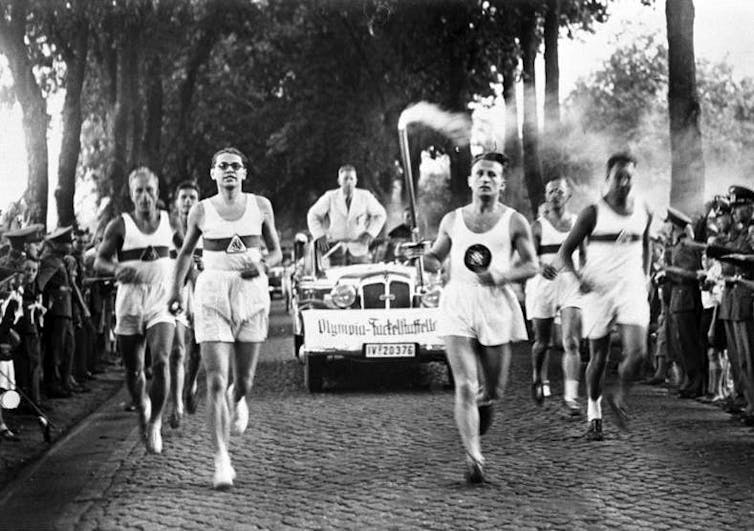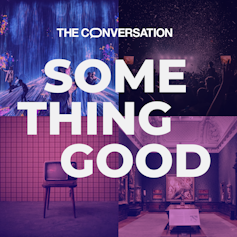If you’re planning to tune in to the Paris Olympics, you probably aren’t just looking forward to the feats of sporting excellence – you’ll be hoping to catch the cultural spectacle of the opening ceremony, too. These flashy events, which kick off each games, aim to tell fresh stories about the host city and country, and set new creative standards for live mega-events.
The ceremonies combine ritual elements from the Olympic Charter (the rules and principles of the International Olympic Committee) such as the athletes’ parade and the raising of the Olympic flag, and cultural performances designed by national organisers. They showcase international Olympic ideals and also communicate things about the host country’s identity and culture.
However, it took decades for Olympic opening ceremonies to reach this scale. At the first modern Olympics in 1896, in Athens, athletes simply entered the stadium to hear speeches and a specially composed hymn – though more than 50,000 spectators still attended.
The 1908 London Olympics, the first to have a purpose-built stadium, were also the first to feature athletes parading in national team uniforms. With almost 700 athletes on the Great Britain and Ireland team, the games affirmed a narrative of Britain as the spiritual home of amateur sport, which ran through into colonial ideas of the British empire’s “civilising mission”.
Opening ceremonies continued in their traditional format after the first world war. At the Paris 1924 Games, the first to be extensively filmed, national teams marched, dignitaries gave speeches and carrier pigeons were released into the air.
A troubling reality for idealistic myths about Olympic history is that the first opening ceremony on a scale like today’s was the 1936 Berlin Games – “Hitler’s Olympics”. Berlin’s opening ceremony applied the stagecraft propaganda of the Nuremberg rallies to a ceremony that aimed to normalise Nazi Germany as a world power, and even employed the same filmmaker who documented the rallies, Leni Riefenstahl.
Olympics researcher Jules Boykoff calls Berlin 1936 the first major example of “sportswashing”, in which states deflect attention from human rights abuses through international sport.

German Federal Archives, CC BY-ND
The torch relay and lighting of the Olympic flame is now a high point of every opening ceremony. In 1936, however, it allowed the Nazis to claim continuity between their Aryan racial ideal and ancient Greek civilisation.
Organisers of the London 1948 Games, after the second world war, reframed the relay tradition as a symbol of international peace and the ancient “Olympic truce”, where warring Greek city-states agreed not to harm enemy athletes during the original games.
Televising the games
Live television transformed opening ceremonies again in 1964, when Tokyo hosted its first games. Now that a global audience would watch ceremonies live, they gained new importance as opportunities for national storytelling and public diplomacy. For instance, selecting 19-year-old Yoshinori Sakai – born in Hiroshima on the day of the US atomic bomb attack – as Tokyo’s torchbearer had deep national meaning and symbolised a new peaceful Japan.
Spectators arguably owe the grand scale of today’s opening ceremonies to cold war rivalry and the ideological struggles around the Moscow 1980 and Los Angeles 1984 Olympics – where each superpower led a boycott of its rival’s games.
Both superpowers also asserted what they saw as superior ideological values through their opening ceremonies. Moscow’s contained what was then the largest ever cultural programme, featuring gymnastics, mass choreography and folk dance. Los Angeles mobilised popular music traditions and Hollywood glitz to advertise consumer culture and the American dream.
After the cold war, opening ceremonies continued to provide opportunities to change how the world saw host countries. The Sydney 2000 opening ceremony, for instance, strove to express a multicultural narrative of Australia which honoured Aboriginal culture, though critics thought the representations were stereotypes.

TSGT Rick Sforza
Sydney’s torchbearer, Aboriginal sprinter Cathy Freeman, became a national hero after winning the women’s 400 metres. Many Australians saw this as a moment of historical reconciliation with Australia’s colonial past.
Opening ceremonies have often also narrated hosts’ identities in contrast to others. In 2008, Beijing’s epic opening ceremony advanced a unified “grand narrative” of China as a historic, world-leading power. London 2012’s creative team contrasted the UK to China with a democratic and quirky image of the nation as a “mosaic” of diverse, individual life stories.
Director of the 2012 ceremony, Danny Boyle, and scriptwriter Frank Cottrell Boyce took inspiration from the filmmaker Humphrey Jennings. Jennings co-founded the Mass Observation social history project (collecting records of daily life from hundreds of volunteer diarists) and made celebrated films about everyday British life during the second world war.
London 2012’s opening ceremony has since become a focus for nostalgic national memory among many who remembered a mood of “happy belonging”. Yet even in 2012 it caused contention, with one Conservative MP Aidan Burley describing it as “leftie multicultural crap”.
More recent opening ceremonies have their own political stories. Sochi 2014’s stirred up national pride in Russian history and culture weeks before Russia annexed Crimea. Rio 2016’s ceremony emphasised Brazil’s environmentalism, and Pyeongchang 2018 saw South and North Korean teams marching together as a step towards peace.
COVID constrained what Tokyo’s and Beijing’s opening ceremonies in 2021 and 2022 could achieve, though Tokyo’s selection of Haitian–Japanese–American tennis star Naomi Osaka as torchbearer gave rare visibility to racial diversity in Japan.
Olympic opening ceremonies often expose the gaps between representation and reality in how nations depict themselves, the silences of their historical narratives and the security politics they demand.
As occasions that can generate globally shared moments of progress but originate in structures of nationalistic and colonial power, opening ceremonies reflect the Olympics’ underlying tension between nationalism and internationalism. They are also the most visible way in which the Olympics bring sport and culture together.
Paris 2024 will be the first opening ceremony since 2018 not to have to work around pandemic restrictions. Its unprecedented format, taking place along a six-kilometre stretch of the Seine, has placed an equally unprecedented security footprint on the host city. While the ceremony is sure to tell a once in a lifetime story about France in 2024, Parisians will have to judge whether it was worth the cost.

Looking for something good? Cut through the noise with a carefully curated selection of the latest releases, live events and exhibitions, straight to your inbox every fortnight, on Fridays. Sign up here.

